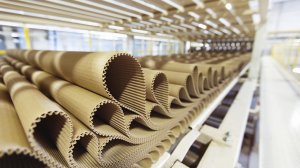Sappi records higher earnings amid better demand, but market volatility remains
JSE-listed paper and packaging manufacturer Sappi has posted a 10% year-on-year increase in its earnings before interest, taxes, depreciation and amortisation (Ebitda) to $183-million for the quarter ended March 31.
This compares with Ebitda of $167-million generated in the same quarter of last year.
Sappi delivered higher earnings despite a 6% year-on-year decrease in sales from $1.44-billion in the prior comparable quarter to $1.35-billion in the reporting quarter.
The group’s headline earnings a share nonetheless decreased by 58% to $0.05 from $0.12 in the prior comparable quarter.
Earnings a share, excluding special items, however, increased by 9% year-on-year to $0.12 apiece.
Sappi CEO Stephen Binnie attributes the higher Ebitda in the reporting quarter to good operating performances across the group, particularly in the pulp segment, as well as significant cost savings.
Sappi recorded a 9% reduction in cash fixed costs following the closures of the Stockstadt and Lanaken mills in Europe, despite incurring a net expense of $46-million related to the closure and restructuring costs for the mills.
Ebitda for the reporting quarter also included a positive plantation fair value price adjustment of $3-million.
The group has observed a modest recovery in global paper markets following an extended destocking cycle in 2023, but underlying market conditions generally remain subdued owing to a challenging macroeconomic environment.
Sappi produces raw materials such as dissolving pulp (DP), wood pulp, biomaterials and timber, as well as end-use products such as packaging papers, speciality papers, graphic papers, casting and release papers and forestry products.
Binnie says DP demand was strong throughout the quarter and was boosted by a tight supply landscape, low downstream inventory levels and high-viscose staple fibre operating rates following the Chinese Lunar New Year celebrations.
The hardwood DP spot market price responded positively through a $60/t increase to $940/t by the end of the quarter.
Graphic paper demand gradually recovered in the reporting quarter as downstream value chain inventories normalised, leading to sales volumes increasing by 7% year-on-year.
Binnie says there has been a structural decline in demand from the highs of 2022, but notes that selling prices have remained stable despite the soft market conditions.
Owing to the group’s cost-saving initiatives, both the DP and graphic paper segments recorded improvements in profitability in the reporting quarter.
Packaging and speciality papers demand rebounded in the quarter under review, with sales volumes improving by 9% year-on-year. There was, however, a mixed performance across regions, with strong recoveries in North American demand and higher sales volumes in Europe, but lower sales volumes in South Africa owing to overstocked paper supply chains.
Selling prices for packaging and speciality papers also came under pressure in the second half of the 2023 financial year and were 13% lower in the reporting quarter, compared with the same quarter of last year.
Binnie says the group’s cost savings were insufficient to offset the negative impact of lower selling prices in this segment, and therefore profitability declined.
Sappi’s capital expenditure (capex) of $64-million in the reporting quarter was lower than that of the same quarter of last year owing to the phasing of capital spending for the Somerset PM2 conversion and expansion project, which will be completed by 2025.
The group’s net debt increased by $150-million in the reporting quarter, compared with the prior comparable quarter, to $1.36-billion, owing to the cash used for the restructuring of the Stockstadt and Lanaken mills, but this was offset by a positive currency translation effect of $31-million – on the back of a stronger dollar on Sappi’s euro-denominated debt.
Sappi had $392-million of cash on hand at the end of the quarter, as well as $662-million in committed unused revolving credit facilities in South Africa and Europe.
The group’s Southern Africa division has subsequently refinanced a R1.5-billion public bond, which spreads the maturity profile of the division.
The bond has two sustainability key performance indicators, making it the first Sappi bond with such targets and successfully leveraging the benefits of its sustainable finance framework.
OUTLOOK
Binnie says the upcoming June quarter is generally the weakest in terms of seasonal demand for products; however, market sentiment continues to improve across all of Sappi’s product segments.
He adds that the group is well positioned with cash and liquidity to manage the current market uncertainties.
In particular, Sappi expects a continued recovery in graphic paper demand in the next quarter, as well as strong demand for packaging and speciality paper in North America and South Africa. European market conditions, however, are expected to remain subdued owing to weak economic performance and low consumer confidence.
Binnie warns that Sappi’s profitability will suffer a $30-million impact in the next quarter, owing to scheduled maintenance shuts at the Saiccor and Somerset mills.
The group expects to spend $500-million in capex for the full 2024 financial year, including $154-million of spend on the Somerset PM2 project.
Ebitda in the coming quarter will likely be below that of the March quarter, but still higher than the June 2023 quarter.
The company remains committed to disciplined capital allocation as it works to reduce its exposure to graphic paper markets, while investing for growth in renewable packaging, DP and biomaterials.
Comments
Press Office
Announcements
What's On
Subscribe to improve your user experience...
Option 1 (equivalent of R125 a month):
Receive a weekly copy of Creamer Media's Engineering News & Mining Weekly magazine
(print copy for those in South Africa and e-magazine for those outside of South Africa)
Receive daily email newsletters
Access to full search results
Access archive of magazine back copies
Access to Projects in Progress
Access to ONE Research Report of your choice in PDF format
Option 2 (equivalent of R375 a month):
All benefits from Option 1
PLUS
Access to Creamer Media's Research Channel Africa for ALL Research Reports, in PDF format, on various industrial and mining sectors
including Electricity; Water; Energy Transition; Hydrogen; Roads, Rail and Ports; Coal; Gold; Platinum; Battery Metals; etc.
Already a subscriber?
Forgotten your password?
Receive weekly copy of Creamer Media's Engineering News & Mining Weekly magazine (print copy for those in South Africa and e-magazine for those outside of South Africa)
➕
Recieve daily email newsletters
➕
Access to full search results
➕
Access archive of magazine back copies
➕
Access to Projects in Progress
➕
Access to ONE Research Report of your choice in PDF format
RESEARCH CHANNEL AFRICA
R4500 (equivalent of R375 a month)
SUBSCRIBEAll benefits from Option 1
➕
Access to Creamer Media's Research Channel Africa for ALL Research Reports on various industrial and mining sectors, in PDF format, including on:
Electricity
➕
Water
➕
Energy Transition
➕
Hydrogen
➕
Roads, Rail and Ports
➕
Coal
➕
Gold
➕
Platinum
➕
Battery Metals
➕
etc.
Receive all benefits from Option 1 or Option 2 delivered to numerous people at your company
➕
Multiple User names and Passwords for simultaneous log-ins
➕
Intranet integration access to all in your organisation





















